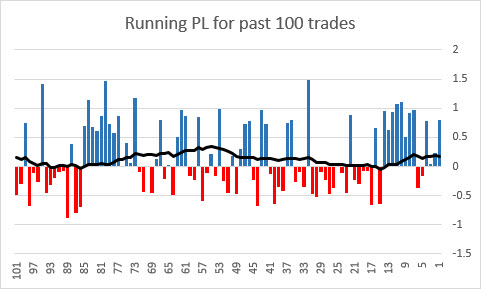Revisiting streaks
In a previous post, I gave a look at my published swing trade record, with a title on the post of Trading is Hard! Let's revisit that concept, almost exactly a month later.
The point of that post was that outcomes are "streakier" than we wish--we will have long strings of wins and losses. These strings can be challenging from an objective standpoint (strings of losses = drawdown). That's bad enough, but strings of wins and losses also create some of the most challenging psychological issues for experienced traders.
When we are in a string of losses, it's easy to feel despondent. We may question if we will ever have a winning trade again, and, in fact, we may question everything: "did I just get lucky?" "Does my system even work?" "Can I do this? Can anyone do this?" We also might extrapolate our recently downward sloping equity curve to see how long it will be until we lose all our money. Maybe we get desperate or frustrated and make trades that don't really follow our plan, trying to "get back to even" (at which point, so we tell ourselves, we will then trade correctly and with discipline.)
Equally dangerous is a string of winners. A trader on a string of winners can feel invincible, but he's not--like all traders, he's always one really poorly-managed and oversized trade away from ruin. If he feels invincible, maybe he takes trades that are too large, too much risk, too many trades. He might extrapolate his equity curve, apply some leverage, and think about what island he wishes to buy.
Both of these results lead to disaster. The solution is simple, but not easy: trade your plan. Simply follow the plan.
In the trading education community, I'm almost alone in my repeated insistence on the importance of understanding randomness. (How this can be true is baffling to me. Trading is clearly a game of probability and understanding the role chance (i.e., randomness) plays in that game is important on every level--mathematically, behaviorally, and psychologically.) One of the reasons for this is that if we understand how streaky random data can be, we won't be surprised to see streaks in our own trading results. We won't internalize the impact of those streaks. We won't assume that noise means anything. In short, we are better able to navigate the challenging market environment.
How have my trades done since then? Here's an update:

In this case, the string of losses was followed by a string of winners, but you can see it's not always like that. (As I write this, we also have open P&L of about 1.5R not reflected on this graph of closed trades--a short in soybean futures and a long in the CHFJPY. If you want to see these trades as they set up, before they happen, check out my research at Talon.)
The takeaway here is simple: we are never as bad as we feel during rough spots in our trading, and never as good as we feel when things are going well. The truth is always somewhere in the middle, just as our ultimate trading results are the average of our actions, system, and trade outcomes.



